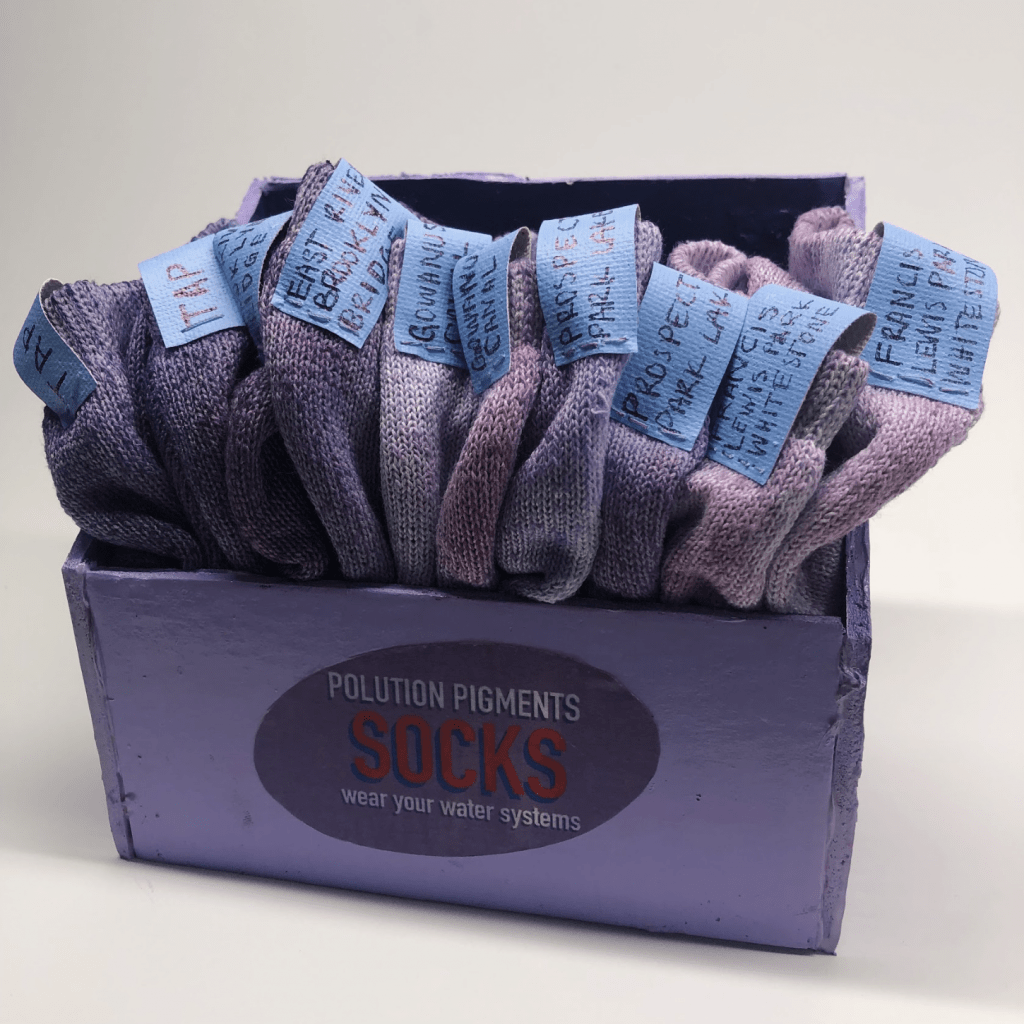Project
For my project I chose to dye socks. Socks are a subtle part of the outfit that you can have a lot of fun with, they are relatively small allowing me to dye 5 pairs, and they make a great subject for the project. I got socks at the dollar store that were labeled as cotton, but once they were dyed you could clearly see the cotton was impure. The dye clung much better to the actual natural fibers in the socks and slipped off the synthetic ones, it was kind of cool that you could see that.
Once my socks we dyed I began thinking of how this would be marketed, what does it mean, what’s the significance, how does it work on a bigger scale? I began with the socks. How would I distinguish where the water for each sock came from? I painted canvas paper light blue, an undertone I saw in the dye and thought complimented the color of the socks. On those pieces I wrote the locations and water bodies and cut them out as little tabs that I sewed onto the back of the socks. The back of the tabs have a number, the pH number of that water. I thought they were small and subtly, informative but still comfortable to wear on the socks. Then it was time to think about the packaging. I created a little foam core box painted purple. The box is lower in the front and higher in the back, to allow for sturdiness but still have the socks be visible. Obviously, as a marketable product, I needed a brand, a logo, and some kind of slogan. I began with a purple oval to match the aesthetic of everything else. I knew a good brand has a catchy name, something that flows. Pollution Pigments. Both words start with P, so it flows nicely, and it covers the basis of the assignment. Pollution alludes to the water samples. We were testing the pH of them and gathering different samples to see the pollution in our surrounding waters. The Pigment part of the name comes from the natural dye process, we created our own pigments to dye the fabrics. Beneath the brand name reads SOCKS to let you know exactly what the product is. Then there is the slogan. I came up with the phrase, “wear your water systems.” I thought it was really cute and catchy and really summarizes the basis of the project, using our surrounding water systems to dye these fabrics. The slogan also sounds nice because it is short and the “wear” and the “water” both start with W making it sound nice. The back of the box has a label giving brief information about the “brand,” the product, and what’s it about.
I think this is definitely applicable on a larger scale, and would be very cool on a larger scale. The basis of the product would be the same, socks dyed with local water and local produce. Those variables would then change. This sample is from New York, red cabbage is something that can be locally grown, and the 5 water sources are from the area. If it were done in Los Angeles, we could use water from Venice Beach and locally grown avocados. Depending on the color of the dye, the color of the box and labels would change. The blurb on the back label would also change, with the accurate information. Doing this, each city/state would have a custom set of socks that has strong ties to their community and teaches something about water pollution.
PUFY 1100 Sustainable Systems Natural Dyeing PH experiment Worksheet
Water and Collection Experience and Analysis (EA): The Natural Dyeing Exercise
A Record of Your Scientific Method
Type or, carefully, handprint your answers. Use the back or an additional page, as necessary.
Date: April 19 Season: Spring
Plant Used: Red Cabbage
Why did you selected this plant for the purpose of creating a natural dye?:
I selected this plant because of its color and pigmentation. The color of the actual cabbage was very pretty and it made a deep purple dye.
Location of water collection (insert image of the location-see below) Make a brief observation of suroundings and state of water:
Water PH:
Tap Water: 3
East River/Brooklyn Bridge Park: 6/7
Gowanus Canal: 6/7
Prospect park Lake: 4/5
Long Island Sound/Whitestone Bridge: 5/6
Which Protocol you are using? Hot dye Protocol
Dye Recipe
Fabric: Cotton Socks
Dye/volume: 4 Cups
Mordant/amount (measure given amount using measuring spoons): Alum 3 tablespoons total
Further Recipe Notes: I added a pinch of salt from a tip I saw online
Before dyeing I boiled the socks in 4 cups of water with a tablespoon of Alum and let cool
Then boil the socks in 1 cup vinegar (Fixitive) and 4 cups water
What do you predict will be the outcome based on your observations?
I predict there will be a difference in color from the tap water to the others because it is the most pure, and the Gowanus Canal water because I assume it was the most toxic.
Extraction process notes (include reflections on what happens in the process of your analysis):
I extracted my dye by boiling 4 cups of cabbage in 4 cups of water for one hour.
Reflections about the pollution results and PH of water conclusion:
The socks came out a lot more similar than I thought they would have. Once I rinsed them I saw a bigger difference, but when they dried they were more similar. Some of the saturation was different but that could have been because of a slight difference in amount of mordant. I think its interesting that they weren’t that different because the water may not be as polluted as we many think, which would be good.
Process Photos
















